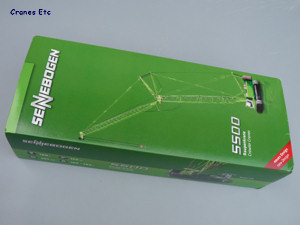 |
|
Sennebogen'Go for Green' branded
box. |
 |
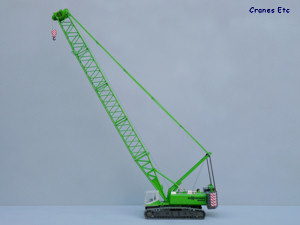 |
|
Rigged with a boom only. |
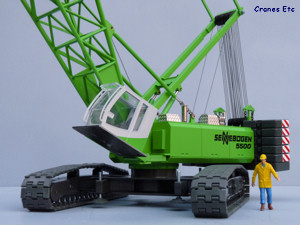 |
| Tilting cab is
plastic. |
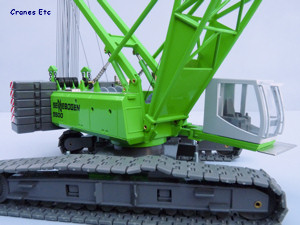 |
| Plastic tracks
look pretty good.
|
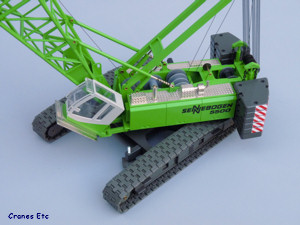 |
| Textured
surfaces on top of the body. |
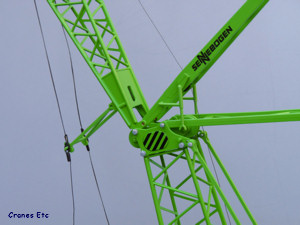 |
| Luffing jib
connection. |
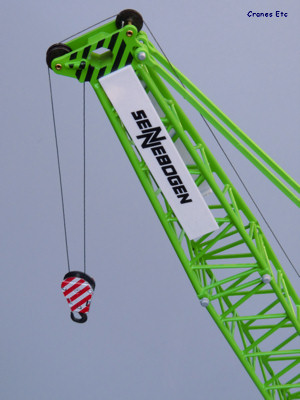 |
| Top of the
luffing jib. The hook looks smart. |
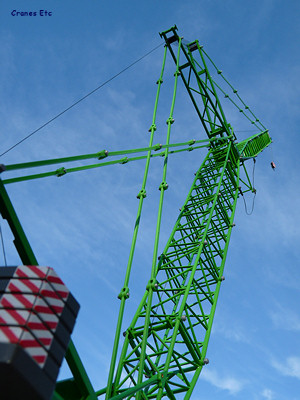 |
| Maximum luffing
jib configuration.
|
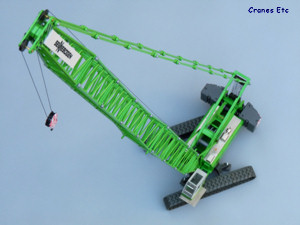 |
| Maximum
non-luffing jib configuration. |
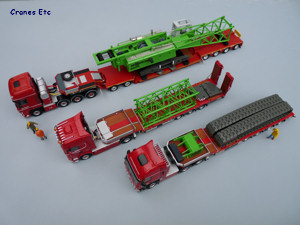 |
| The 5500 makes
excellent transport loads.
Nooteboom trailers do the honours. |
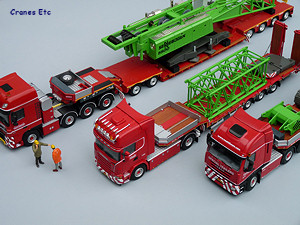 |
| 'Did you bring
the instruction manual?' |
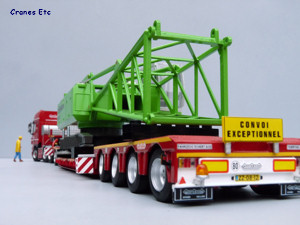 |
| Body loaded on
a Nooteboom Euro Low Loader. |
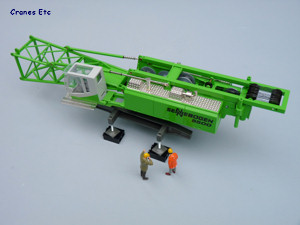 |
| Standing on the
jacks. |
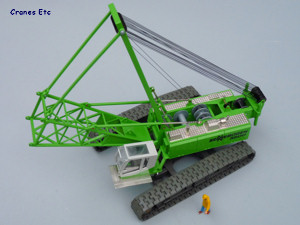 |
| Tracks fitted
and ready for the counterweight. |
|
The model of the Sennebogen 5500 was
the first mass-produced large crawler crane model and it
appeared as a prototype at the BAUMA exhibition in 2001,
and went on sale in 2002.
This version is in Sennebogen's 'Go for Green' livery and
is updated with some revisions to the original
model.
Packaging
The box sleeve reflects the Green Line branding and
contains two
polystyrene trays which have a large number of
individual pieces securely packed.
The review model was undamaged although there were two
manufacturing defects affecting the luffing jib
retaining ropes and the counterweight tray fixing.
Both issues were quickly resolved by Conrad.
An instruction sheet is provided, complete with
pictures, and it is in German and English. Although
helpful, it does not describe all aspects of the
assembly including the reeving of the luffing jib and
which winch drums to use. The winch drums should be
used as follows (numbering the winch drums 1 to 4 from front to back):
- 1
is used for the hook when there is only a main boom or
for the hook for the luffing jib if the crane is
using two hooks;
- 2 is used for the hook on the main boom when the
luffing jib is attached;
- 3 is a
double drum and controls the luffing of the main boom
using the pulleys on the A-frame (except the centre
pulley);
- 4 controls the luffing jib - the rope
goes under and around the single pulley on the body
and then up and over the centre pulley on the A-frame
and on up to the luffing gear pulleys.
Rigging the model takes some time and the instructions
are not as clear as they could be so a complete novice
might have some difficulty. In particular stringing up
the luffing gear requires patience and perseverance.
Detail
Each crawler track comes as a separate unit. The tracks
themselves are plastic made up of a large number of
interlocking sections. They look very good although
they are occasionally a little stiff so do not always
lie naturally. The only other moving parts on the track
frame are the main sprockets.
The main piece of the model crane consists of the cross
frame that links the two track frames, the crane body and first section
of boom. The cross frame snaps into position into
openings in the track frames and this provides a robust
fixing mechanism.
The cab is plastic
with grab rails and good interior details such as foot
pedals. The main body is relatively uncomplicated
except at the rear where the counterweight attachment
mechanism is modelled well, and is complete with cylinders and
lifting chains although the cylinder pistons would look
better if they were silver rather than green.
Four separate winches are available to be used: one for
luffing the main boom, one for the luffing jib and two
winch lines. The pulleys on the body and A-frame are
metal rather than the plastic of the first version of
the model and they are much better and roll freely.
The counterweight plate attaches with a pin and pairs of five weights
sit on top. Each counterweight
piece is cast with lifting lugs and is painted to
produce a very pleasing result. Not included on the
model are the ballast plates used on the real machine
which span between the track frames front and rear and
these would have added to the stability
of the model.
The first section of
the main boom is permanently fixed to the crane body
together with spring-loaded bars to prevent the boom
being over luffed into a vertical position. All sections of
the boom are made extremely well and look just great.
They join together using the plastic pin system which is
very effective.
The main boom head has
snap-in large plastic pulleys which are satisfactory but
perhaps not the best in their ability to free-roll, and they also appear to have an
over-large separation between the sheaves.
With the luffing jib attached an excellent cable
arrangement is provided to prevent the jib over-luffing and the thread type
hangs more naturally than on the original version of the
model.
The
pendant bars used to support the boom and jib are all modelled
in tough plastic and these are another revision from the
original model. They are pinned together so they
remain straight under tension and are a big improvement.
There is no dolly wheel at the end of the fly
jib and this would have been a worthwhile addition to
the updated model.
The hook is only
a single pulley affair but looks smart with chevron
stripes. It is metal and looks fine on
the fly jib but the main boom really calls for something
larger and again it would have been a nice improvement
on this update.
Features
The cab is mounted on a tilting and hinge arrangement so
that it can be moved inward to reduce the crane width
during transport and can be rotated upward to aid the
driver during lifts at height. As a minor detail it
would have been better if the walkway outside the cab
had been hinged so that it can be stowed during
transportation.
The four winches are operated by keys which are metal. They can also be
removed when not used so they do not distract from the
look although the holes remain.
The main strength of this model is the large variety of
ways the model can be displayed. It can be fully broken
down for transport so looks excellent on the appropriate
haulage vehicles. It can also be displayed in various
stages of assembly.
The crane can be rigged a number of ways. It can have
just a main boom of various lengths, including very
short if you want it. It can have a luffing
jib of different lengths giving an overall model height
of about 1.2m. Another option arises because the
reducer section at the top of the main boom can have jib
sections directly attached to create a long boom
with reducing section towards the top. Under this
configuration the model stands around 1.1m high.
In terms of stability the model is fine with the boom
and jib up but less so when they are at a big radius.
Quality
The casting of the boom
sections is very good and overall the model has a high
quality feel notwithstanding the production errors on
the review model.
The Sennebogen 'Go for Green' paint scheme looks really good
and the few graphics are sharp.
Price
Relatively speaking the model is now better value for money.
Overall
Although it is around 10 years since it first appeared,
this is still a great looking crane model and the small
improvements made to this version have been worthwhile.
It would have been nice if a few more changes had been
made such as metal tracks and ballast plates between the
track frames but no doubt this would have cost more.
It remains easy to recommend.
Footnotes
The Sennebogen 5500 crawler crane was originally made in
yellow and grey livery and was reviewed
here. The base model comes with the
full complement of ballast weights as per the real
crane. An extension kit was produced which
included an extra main boom
section and an extra jib section. It also had extra
ballast weights which add stability to the model but in
total are more than the real machine uses.
The model
was withdrawn from Conrad's online model list in
February 2006. In December 2006 a version in Mammoet
colours was introduced in a limited edition of 300
models. The extension set was also available in Mammoet
colours.
In 2011 this updated version was introduced, and it
was also made available in Franz Bracht colours as model
number 2733/03.
|
|
|
|
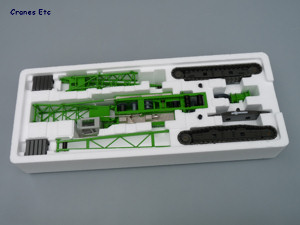 |
| Bottom tray. |
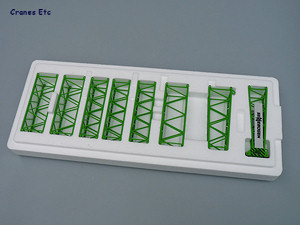 |
| Top tray.
|
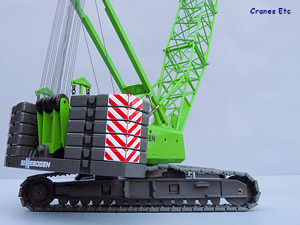 |
| Counterweight
slabs are well formed. |
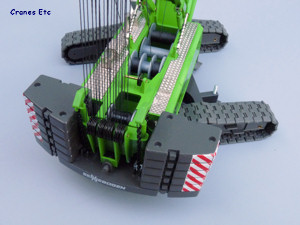 |
| Metal pulleys
are a big improvement on this version of the model. |
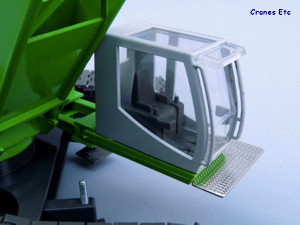 |
| Simple cab
interior. |
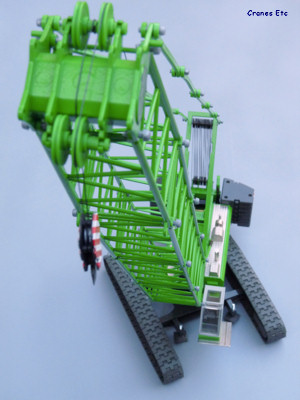 |
| Small hook for
a big boom. Only two pulleys are fitted on the
front of the boom head so they roll better. |
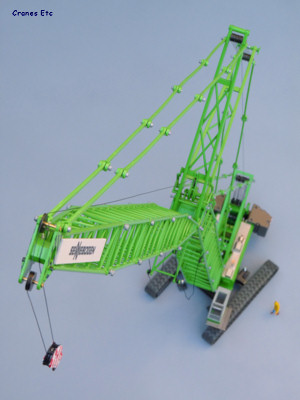 |
| Pendants are
much improved and are straight. |
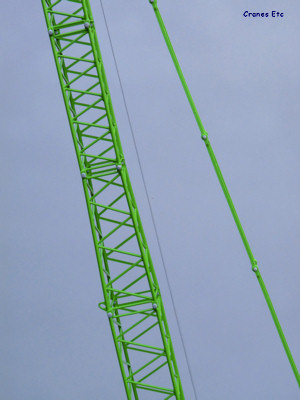 |
| Using the
reducer section to produce a long boom. |
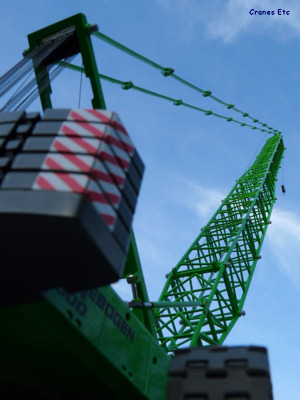 |
| Impressive boom.
|
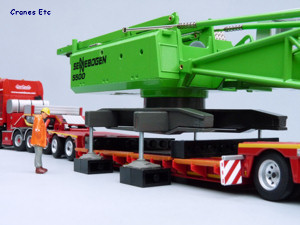 |
| Body lifted up
so the low loader can drive away. |
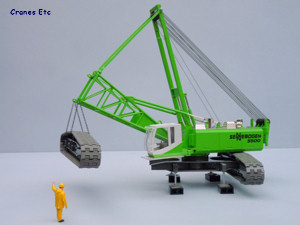 |
| Self loading
one of the track assemblies. In reality it really
needs a winch line to lift the load. |
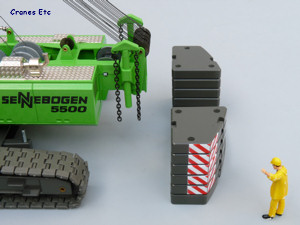 |
| Moving in to
self-lift the counterweight. |
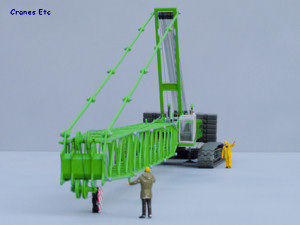 |
| Ready for boom
up. |
|

